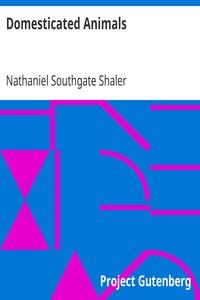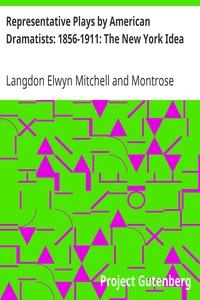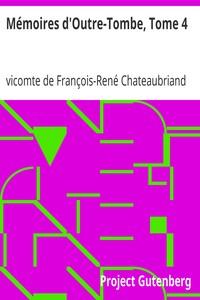|
|
Read this ebook for free! No credit card needed, absolutely nothing to pay.Words: 37724 in 7 pages
This is an ebook sharing website. You can read the uploaded ebooks for free here. No credit cards needed, nothing to pay. If you want to own a digital copy of the ebook, or want to read offline with your favorite ebook-reader, then you can choose to buy and download the ebook.

: Domesticated Animals Their Relation to Man and to his Advancement in Civilization by Shaler Nathaniel Southgate - Domestic animals Animals-Domestic@FreeBooksWed 07 Jun, 2023 t, this method of rearing and feeding is still common. It was and is advantageous, for the reason that the creature, by its remarkably keen sense of smelling and its singular capacity for overturning the ground, is able to provide itself with abundant food in the way of grubs and roots which are not at the disposition of any other animal. It was only as the public forests disappeared that pigs came to receive any considerable part of their provender from the products of tilled fields. In this stage of our agriculture, when all the land was possessed, the life of the pig was necessarily more restricted, and he became the denizen of a pen. In the earlier state there was no cost for his keeping; in the latter, except so far as he could be fed from the waste of a household, he is an expensive animal. It is with this last state of the pig, when he became the most housed of our domesticated animals, that the work of the breeder really began. The aim of those who have developed the pig has been, as we have said, to obtain the most rapid growth along with the greatest weight of fat, and to accomplish the results with the least expenditure in the way of food. Although the animal has been subjected to selective experiments, looking to these ends, for not more than a century, or say about forty generations of the species, the amount of variation which has been attained is singularly great, the form and habits having been changed more rapidly, and in a larger measure, than in the case of any other of our domesticated animals. It may fairly be said that this creature is more obedient to the will of the practical selectionist than any other with which we have experimented. It is commonly assumed that our pigs are among the least intelligent of the creatures which man has turned to his use. This impression is due to the fact that the conditions in which these animals are kept insure their degradation by cutting them off from all the natural mental training which wild animals, as well as the other tenants of the fields, receive. In the state of nature or in the condition of domestication which existed before pigs became captives in their pens, they were among the most alert and sagacious animals with which man has come in contact. Their wits were quick and their sympathies with their kind remarkably strong. Trainers have found these creatures more apt in receiving instruction than any other of our mammals, and the things which they can be made to do appear to indicate a native intelligence nearer to that of man than is found in any other species below the level of the apes. As there is little in the books of anecdotes of animals concerning pigs, I venture to give an account of a learned individual of this species whose performances I had an opportunity of observing in much detail. The creature, an ordinary specimen about three years old, had been trained by a peasant in the mountain district of Virginia who made his living by instructing animals for show purposes. He stated that in selecting pigs for education it was his practice to choose those characterized by a considerable width between the eyes and whose skulls projected in this part of their periphery to a more than usual degree. He said that from many experiments he was satisfied that there was a very great difference in the capacity of the animals to receive training, and that the above-mentioned indices afforded him sufficient guidance in his choice. In the exhibition about to be described there were but three persons present, myself, another spectator, and the showman. A score of cards were placed upon the ground, each bearing a numeral or the name of some distinguished person. These cards were in perfect disorder. I was allowed, indeed, repeatedly to change their position and to mix them up as I pleased. The pig was then told to pick out the name of Abraham Lincoln and bring it to his master. This he readily did. He was asked in what year Lincoln was assassinated. He slowly but without correction brought one by one the appropriate numerals and put them on the ground in due order. Half a dozen other questions concerning names and dates were answered in a similar way. Each success was rewarded with a grain of corn, and for his failures the creature received a reasonable drubbing. It was evident that the animal had to consider in making his choice of the cards. At times he was evidently much puzzled and would indicate his perplexity by squealing. It seemed clear that the master of this learned pig did not guide the movements of the animal by other indications than words. The questions, in some cases, had to be reiterated in a loud voice in order to insure attention. Several times during the performance the pig rebelled, broke from the tent, and was with difficulty recaptured. The creature disliked this task in the manner of a lazy school-boy, and at the end of an hour of exercises seemed utterly overcome by his labor. He ran into the box where he was ordinarily confined, and when dragged forth, neither rewards nor punishments would quicken him to further work. The above-described exhibition made it plain to me that the pig can be taught to understand a certain amount of human speech and to associate memories with phrases substantially as we do ourselves. It is perfectly clear that the performance which I witnessed was not a mere routine action, for I had a number of questions asked over again so as to make it sure that the creature acted with reference to each separate inquiry. The behavior of the animal during the performance seemed clearly to indicate mental effort and not mere automatic memory. His attitude when trying to determine which of two cards to take distinctly showed that he was intently viewing the figures and endeavoring to come to a decision. I am aware it has been suggested that learned pigs discriminate between the cards by peculiarities of odor which have been given to these bits of paper. I sought carefully to find if such was the case, and though I have a very keen sense of smell I found nothing which led me to suspect that this device was used. Even if such were the case, the rationality of the animal's action would be none the less clear. The showman assured me that he never used any such means in training pigs. He seemed, indeed, to treat the suggestion with contempt. Although experiments in the training of pigs show that they have rather remarkable intellectual capacities, the most human feature in their mental organization is found in the keen sympathy which they exhibit with the sufferings of their own kind and the willingness with which they encounter danger in protecting their comrades. It usually requires close observation for the naturalist to determine the existence of this motive among the other wild or domesticated mammals. In fact, the traces of it are very slight indeed, and are generally to be attributed to the care of parents for offspring or of the males for their harem--a disposition which, though akin to the defence of the kind, is nevertheless of a special and peculiar nature. Even among our domestic dogs, whose sympathies have been developed in a remarkable degree and who will sacrifice their lives to defend or rescue the human beings with whom they are familiar, there appears to be but little disposition to support members of their species who may be assailed. With pigs, however, as is well known to all those who have observed their habits, the characteristic cry of distress of their fellows proves very exciting and stimulates all the adults, both male and female, who hear it to hasten in defence of their kinsmen. It is a noteworthy fact that while most other animals when in danger utter no distinct or continuous cry, the pig gives voice in a vociferous and insistent manner, as if he had a right to expect the sympathy and help of his species. The cry goes with the custom of defence which in this species has attained a better foundation in the sympathetic motives than in any other mammal below the level of man. It is perhaps due to their relatively high intellectual organization that the excessively domesticated pigs are liable to suffer from attacks of mania. This is most commonly exhibited by the sows, which at times will destroy their young shortly after they are born. The sight of their progeny seems to infuriate them in a curious manner. One sow which I owned killed three successive litters; another fine animal of the Berkshire breed, a very amiable, indeed affectionate, creature, was carefully watched at the time she first bore young, precautions being taken to prevent her from harming them; she would willingly allow them to suckle, provided she did not see them, but the moment she laid her eyes upon them she was seized with the strange fury. Although this singular perversion of the natural instincts of maternity sometimes occurs among the pigs which are allowed to roam together in herds, it seems to be far more common in those conditions where the animals are confined in pens without contact with their kind, and where they have no chance to recognize the young as members of their species or to acquire that interest in them which they would gain in the society of the herd. It is also clear that this maniacal habit is inherited; according to my observation it is common among the Berkshire, and relatively rare in other less specialized varieties. The intelligence of the pig is also shown in the readiness with which the creature changes its habits to meet varied environments. Thus the pigs which range the woods in the western and southern parts of the United States have learned to catch the crawfish which abounds in the shallow streams in those parts of this country. They will wade up a brook, turning over the stones and driftwood as they go, catching with a quick movement the crustaceans which they have thus dislodged from their cover. Along the shores of the Bay of Fundy, the pigs, accustomed to follow the tide out, picking the chance food which is thus exposed to them, have learned carefully to avoid the risk of being caught by the returning waters. With the first splash of the turning tide they hasten inshore until they have attained safe ground. One of the best evidences of the mental state of these animals is found in their actions when assailed by dogs or other beasts of prey. Pigs, though wary and sensible of danger, seem exempt from the extreme fear which leads to panic, and fight, even before being brought to bay by long chasing, in a discreet and valiant manner. Where a number of them are attacked by dogs or other enemies, they will form a circle with their heads out, each supporting the other in such a manner that the ring cannot readily be broken. Their thick-skinned forequarters and stout tusks provide them with excellent instruments with which to resist an assault. Free books android app tbrJar TBR JAR Read Free books online gutenberg More posts by @FreeBooks
: Northern Nut Growers Association Report of the Proceedings at the Fifteenth Annual Meeting New York City September 3 4 and 5 1924 by Northern Nut Growers Association Editor - Northern Nut Growers Association Periodicals; Nut trees Periodicals; Nuts Periodi@FreeBooksWed 07 Jun, 2023

: Representative Plays by American Dramatists: 1856-1911: The New York Idea by Mitchell Langdon Elwyn Moses Montrose Jonas Editor - American drama@FreeBooksWed 07 Jun, 2023
|
Terms of Use Stock Market News! © gutenberg.org.in2025 All Rights reserved.






